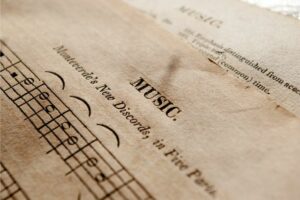
Music plays an important role in many people’s lives, so the topic of how to describe music in writing is an important one.
Some songs invoke memories:
- A first dance,
- An important summer in childhood,
- A song a loved one sang while they worked.
Music can be equally important in writing by adding a sensory level to the story for both the characters and the reader.
Take a free trial of Fictionary today and take your story to the next level.
The challenge a writer faces when considering how to describe music in writing is the same challenge a writer faces in describing any sensory experience that must connect to a wide readership. Every reader will:
- Taste,
- See,
- Feel, and;
- Hear in their own way.
For this reason, we often see the best musical descriptions used to reveal character more than to reveal the music itself.

How to Describe Music in Writing
Music, much like other sensory elements in a story, will be most effective if its presence serves multiple purposes to the scene or chapter. Consider the following ways music can add layers to the writing:
- Creates tone in a scene
- Triggers a flashback for a character
- Reveals a character’s mood
- Foreshadows
- Increases tension
Writers using music to establish one or more of the above examples will notice a deeper connection music has in the story and are fantastic ways to think about how to describe music in writing.
Words to Describe Music
For writers who are still wrestling with the subtleties of how to describe music in writing, traditional terminology may be more effective. So here are some adjectives and unique words you can use to describe music. We have also added a list of words that can specifically describe a melody if you require more technical terminology.
Adjectives to Describe Music
- Acoustic
- Ambient
- Bittersweet
- Bluesy
- Catchy
- Dynamic
- Electric
- Energetic
- Enchanting
- Epic
- Ethereal
- Expressive
- Funky
- Gentle
- Groovy
- Haunting
- Harmonic
- Hypnotic
- Intense
- Jazzy
- Joyful
- Lyrical
- Majestic
- Melancholic
- Melodic
- Mesmerizing
- Nostalgic
- Orchestral
- Passionate
- Poignant
- Powerful
- Rhythmic
- Sentimental
- Soothing
- Soulful
- Symphonic
- Tranquil
- Uplifting
- Vibrant
Unique Words for Music
- Allegro
- Andante
- Arpeggiated
- Atonal
- Cadence
- Cantabile
- Chromatic
- Crescendo
- Decrescendo
- Diatonic
- Dissonant
- Discordant
- Euphoric
- Forte
- Glissando
- Harmonic
- Harmonious
- Homophonic
- Improvised
- Legato
- Maestoso
- Melancholy
- Modulated
- Motif
- Overture
- Pianissimo
- Polyphonic
- Presto
- Resonant
- Rhapsodic
- Rubato
- Serene
- Sonata
- Sostenuto
- Staccato
- Syncopated
- Syncopation
- Timbre
- Tonic
- Vibrato
Words to Describe Melody
- Arrangement
- Cadence
- Contour
- Figure
- Harmony
- Hook
- Interval
- Lilt
- Line
- Motif
- Notation
- Passage
- Phrase
- Progression
- Refrain
- Rhythm
- Sequence
- Strain
- Theme
- Tune
Examples of Ways to Describe Music in Writing
And now lets move on to some examples of authors who have successfully used a music in writing.
How to describe music in writing, Example 1: A Visit from the Good Squad by Jennifer Egan
In A Visit from the Good Squad, Jennifer Egan unravels a series of narratives surrounding an aging rock star who becomes a record executive. Aside from winning a Pulitzer Prize in 2011 for her work, she shows skill in expressing music in her writing.
“And then I notice the music flooding out of every part of the apartment at once – the couch, the walls, even the floor – and I know Bennie’s alone in Lou’s studio, pouring music around us.”
From this passage, the reader gets the impression of the pressure the music has, expanding the room and enveloping the characters.
The music is not heard, so much as it is felt, and the description of feeling is one any reader can understand as all encompassing. In this example, we see the type of music is not important, but rather the way it becomes an entity taking over the space.
How to describe music in writing, Example 2: Bel Canto by Ann Patchett
Bel Canto by Ann Patchett won the Orange Award and the PEN/Faulkner Award in 2001 and tells the story of a Japanese businessman and opera fan who encounters a hostile takeover at his own birthday celebration.
Patchett shows the importance of music for this character in the following passage.
“It was early in the second act, when Rigoletto and Gilda sang together, their voices twining, leaping, that he reached out for his father’s hand. He had no idea what they were saying, nor did he know that they played the parts of father and daughter, he only knew that he needed to hold onto something.”
Much like the above example from Egan, Patchett does not necessarily describe the music itself, but the impact it has on the character. The vulnerability felt by
this character is one every reader can relate to, whether they are a devoted fan of opera or a reader with no experience of the art form.

How to describe music in writing, Example 3: Never Let Me Go by Kazuo Ishiguro
Kazuo Ishiguro uses a song from his writing to title his novel in Never Let Me Go, which was shortlisted for the Man Booker Award in 2005. In his dystopian science fiction novel, the narrator Kathy connects to a song she finds in her childhood.
“It’s slow and late night and American, and there’s a bit that keeps coming round when Judy sings: ‘Never let me go…Oh baby, baby… Never let me go…’
The music is described in a more obscure way here, slow, late night, American.
Unlike the above examples, these descriptions are not only more specific to the music itself, but they also leave room for interpretation by the reader.
And yet, a reader can sense the music, feel it, and know how it is affecting this character as she navigates a difficult self-realization in this scene. Additionally, this song reveals a deeper meaning to both the character and the reader as she comes to understand what is at stake for her throughout the novel, making the song title a brilliant title for the novel itself.
Other writers use music to direct the reader and show structure to the writing.
Robert Galbraith, (pseudonym for J.K. Rowling), uses lyrics from the American rock band, Blue Oyster Cult, to begin every chapter of her novel, Career of Evil (2015). The lyrics are carefully chosen and offer the reader insight into tension and conflict in the coming chapter.
Emily St. John Mandel shows the importance of art and music in a society collapsed after a pandemic in her novel, Station Eleven, a winner of the Arthur C. Clarke Award and a finalist for both the National Book Award and the PEN/ Faulkner Award in 2014.
Mandel never overtly describes the music in her Traveling Symphony, though she names characters by the instruments they play.
The first flute is “irritated” and the second horn “petty”.
She attributes character traits to the instruments they play, revealing the identifying nature of the music for these characters surviving an end of world scenario.
For these writers, music is a means to reveal character and story.
How to Describe a Song Conclusion
Writers will find music can deepen their story by offering sensory details to the writing while also adding layers to the character and plot. Much like those memories music evokes for many of us, music can be the fabric of life for the characters we write.



